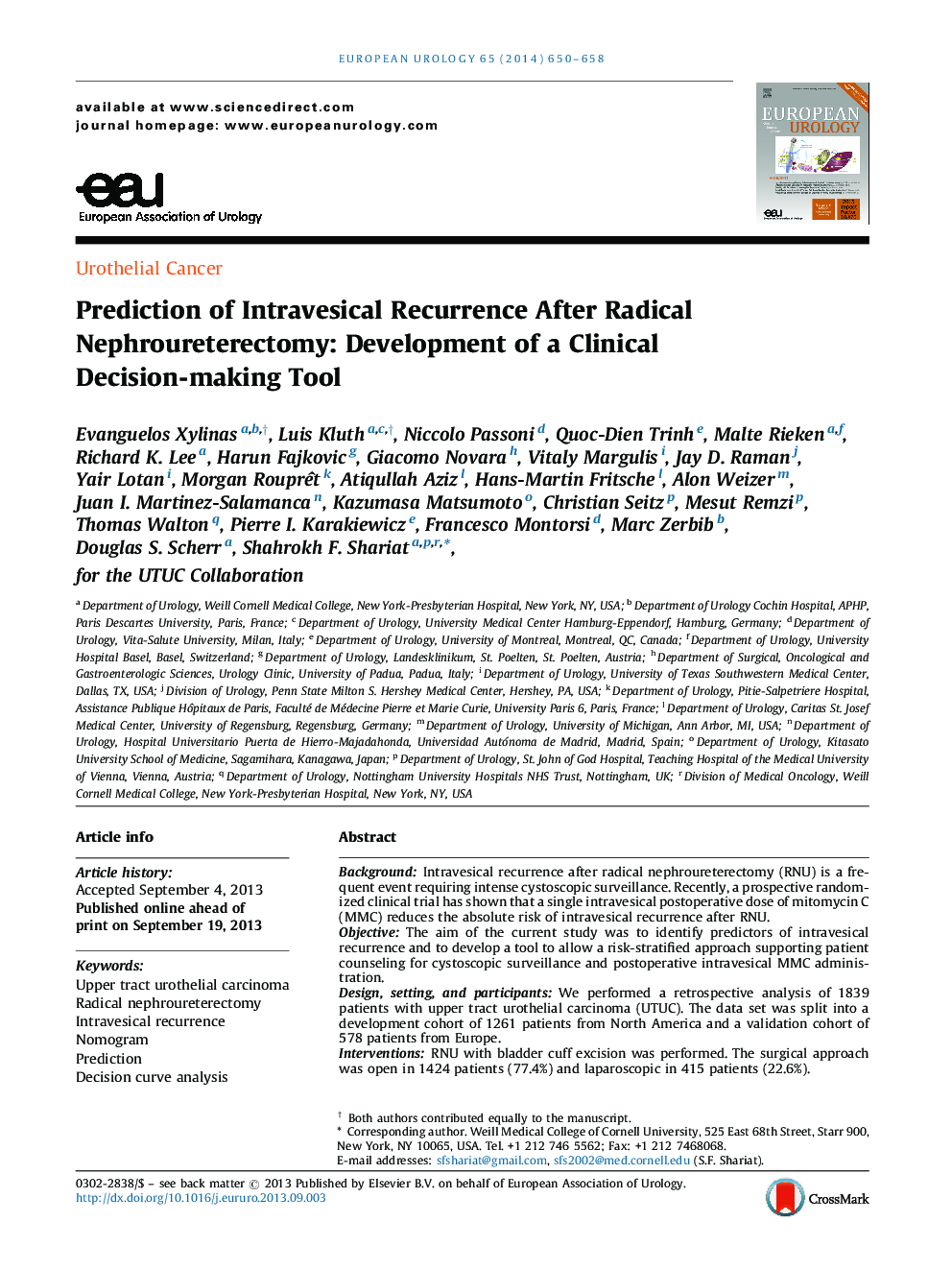| کد مقاله | کد نشریه | سال انتشار | مقاله انگلیسی | نسخه تمام متن |
|---|---|---|---|---|
| 6176871 | 1253066 | 2014 | 9 صفحه PDF | دانلود رایگان |
BackgroundIntravesical recurrence after radical nephroureterectomy (RNU) is a frequent event requiring intense cystoscopic surveillance. Recently, a prospective randomized clinical trial has shown that a single intravesical postoperative dose of mitomycin C (MMC) reduces the absolute risk of intravesical recurrence after RNU.ObjectiveThe aim of the current study was to identify predictors of intravesical recurrence and to develop a tool to allow a risk-stratified approach supporting patient counseling for cystoscopic surveillance and postoperative intravesical MMC administration.Design, setting, and participantsWe performed a retrospective analysis of 1839 patients with upper tract urothelial carcinoma (UTUC). The data set was split into a development cohort of 1261 patients from North America and a validation cohort of 578 patients from Europe.InterventionsRNU with bladder cuff excision was performed. The surgical approach was open in 1424 patients (77.4%) and laparoscopic in 415 patients (22.6%).Outcome measurements and statistical analysesUnivariable and multivariable Cox regression models addressed time to intravesical recurrence after RNU. We developed a nomogram for prediction of the probability of intravesical recurrence at 3, 6, 9, 12, 18, 24, and 36 mo. Predictive accuracy was quantified using the concordance index. Decision curve analysis was performed to evaluate the clinical benefit associated with the use of our nomograms.Results and limitationsWith a median follow-up of 45 mo, intravesical recurrence occurred in 577 patients (31%). The probability of intravesical recurrence-free survival at 6, 12, 24, and 36 mo was 85% ± 1%, 78% ± 1%, 68% ± 1%, and 47% ± 2%, respectively. In multivariable Cox regression analysis, advanced age, male gender, ureteral tumor location, laparoscopic surgical technique, endoscopic distal ureteral management, previous bladder cancer, higher tumor stage, concomitant carcinoma in situ, and lymph node involvement were all significantly associated with intravesical recurrence (p values â¤0.04). The nomograms were highly accurate for predicting intravesical recurrence in the external validation cohort (concordance index of 67.8% and 69.0% for the reduced model and the full model, respectively), and calibration plots revealed only minor overestimation beyond 24 mo. If one decided to perform postoperative instillation based on the risk of intravesical recurrence of 15% at 24 mo, one would spare 23% of the patients while not preventing only 0.3% of intravesical recurrences. The lack of information on the stage and grade of the intravesical recurrences is the main limitation of the study.ConclusionsIntravesical recurrence after RNU is a common event in patients with UTUC. We developed nomograms that predict intravesical recurrence after RNU with reasonable accuracy. Such nomograms could improve the clinical decision-making process with regard to cystoscopic surveillance scheduling and postoperative intravesical instillations of MMC after RNU.
Journal: European Urology - Volume 65, Issue 3, March 2014, Pages 650-658
